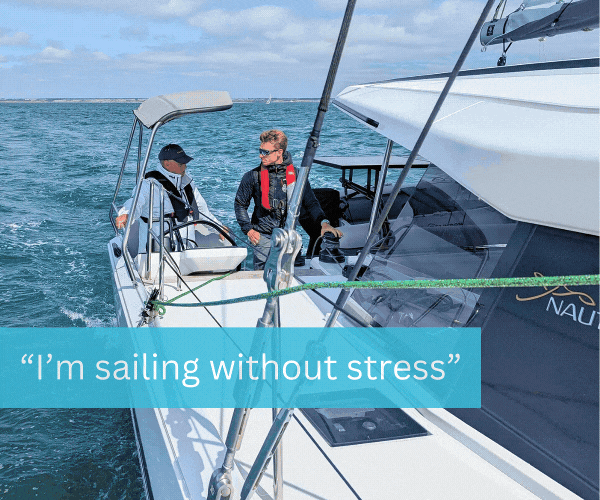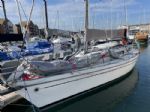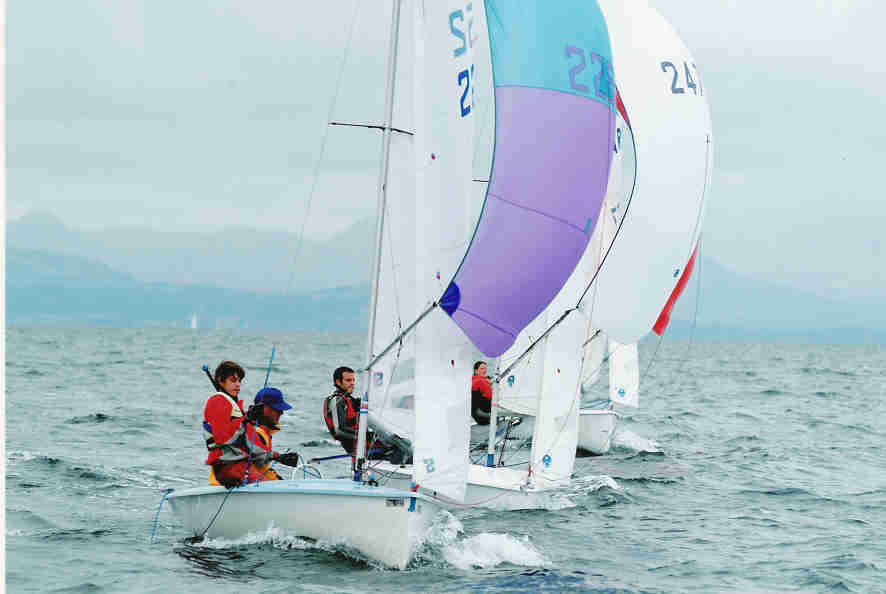











| Rossiter Pintail Mortagne sur Gironde, near Bordeaux |
 |
| Laser 28 - Excellent example of this great design Hamble le rice |
 |
| Laser 140101 Tynemouth |
 |
List classes of boat for sale |
rig tension .. up or down |
Post Reply 
|
| Author | |
redback 
Really should get out more 

Joined: 16 Mar 04 Location: Tunbridge Wells Online Status: Offline Posts: 1502 |
 Post Options Post Options
 Quote Quote  Reply Reply
 Topic: rig tension .. up or down Topic: rig tension .. up or downPosted: 10 Oct 09 at 7:48pm |
|
Another point worth making for boats that cannot easily adjust rig tension on the move. When you rake the mast back for strong winds use two (2) pins, one above the other and both through the eye of the shroud. Then if the wind drops you slaken the rig enough to remove the lower of the 2 pins and re-tension. This decreases the rake and there is no risk of letting the rig fall over the side.
|
|
 |
|
redback 
Really should get out more 

Joined: 16 Mar 04 Location: Tunbridge Wells Online Status: Offline Posts: 1502 |
 Post Options Post Options
 Quote Quote  Reply Reply
 Posted: 10 Oct 09 at 7:41pm Posted: 10 Oct 09 at 7:41pm |
|
The link between rig tension and luff sag is not simple. Sure at low wind speed the rig tension will keep the luff straight. But there is a wind speed where the leeward shroud goes slack. When that happens the rig tension is not controlling the luff sag, but the windward shroud is, and so too is the mainsheet tension. On some boats (where the kicker is attached to the hull and not the mast ie Enterprise and Scorpion) the kicker contributes to luff tension and on trapeze boats the crew takes weight off the windward shroud and thus decreases the luff tension. So its quite complicated. Its certain that the more rig tension you carry the higher the windspeed these other factors begin to take effect. Hence on the 4000 which has a very stiff hull quite high rig tensions are used and that's possibly why its such a fabulous boat to sail in a blow. |
|
 |
|
Granite 
Far too distracted from work 

Joined: 12 May 04 Location: Scotland Online Status: Offline Posts: 476 |
 Post Options Post Options
 Quote Quote  Reply Reply
 Posted: 07 Oct 09 at 12:50pm Posted: 07 Oct 09 at 12:50pm |
|
When it gets windy you want the mast to bend more to flatten the sail, so putting the rig tension off or on depends on weather the spreaders tend to straighten or bent the mast with increasing tension.
It is important to understand that the length of the forestay controls the rake and the length of the shrouds controls the rig tension (at a particular rake) From some of the above comments it shows that for some types of boats having a saggy luff is less important than raking the mast back when the wind increases and you are on the water and can't change the shrouds. |
|
|
If it doesn't break it's too heavy; if it does it wasn't built right
|
|
 |
|
Garry 
Really should get out more 

Joined: 18 Apr 04 Location: United Kingdom Online Status: Offline Posts: 536 |
 Post Options Post Options
 Quote Quote  Reply Reply
 Posted: 06 Oct 09 at 7:35pm Posted: 06 Oct 09 at 7:35pm |
|
It allows the top of the mast to bend off spilling wind. Personally I would shorten the spreaders in strong wind (as well as raking back). The disadvantage of letting the tension off is it then allows the jib luff to sag slightly so you loose a degree or two of pointing. I really think this is very boat specific, go with what your class top sailors do. Garry |
|
|
Garry
Lark 2252, Contender 298 www.cuckoos.eclipse.co.uk |
|
 |
|
NickA 
Really should get out more 
Joined: 30 Mar 05 Location: United Kingdom Online Status: Offline Posts: 784 |
 Post Options Post Options
 Quote Quote  Reply Reply
 Posted: 06 Oct 09 at 7:24pm Posted: 06 Oct 09 at 7:24pm |
|
Take redback's point about mast deflection. Slacker rig should give better gust response by allowing the middle of the mast to bend at a lower wind force (lowers permitting). But also, less tension = less mast prebend and a fuller more powerful main. As for rake, less tension = more rake, with the usual effects of a bigger slot, a lower mast tip and hence less power and less heeling force. But when setting up on the beach (rather than adjusting on the water), surely the way to get more rake is to go down on the shrouds, pulling the mast back, not to reduce the rig tension (ie simply lengthening the forestay).. Still confused. Edited by NickA |
|
|
Javelin 558
Contender 2574 |
|
 |
|
damp_freddie 
Far too distracted from work 

Joined: 20 Oct 05 Location: Aruba Online Status: Offline Posts: 339 |
 Post Options Post Options
 Quote Quote  Reply Reply
 Posted: 06 Oct 09 at 1:16pm Posted: 06 Oct 09 at 1:16pm |
|
...letting it off on both the caps (uppers ) and diaganals (inners)?
On some keel boats slacking the rig is a dubious means of depowering, allowing the mast to fall off to leeward and opening the leech- poor man's gust response top section! Some Tasar sailors did this as well come to think of it. |
|
 |
|
Rockhopper 
Really should get out more 
Joined: 16 Nov 07 Location: Eastry Online Status: Offline Posts: 642 |
 Post Options Post Options
 Quote Quote  Reply Reply
 Posted: 06 Oct 09 at 12:00pm Posted: 06 Oct 09 at 12:00pm |
|
The 5000s is the same when the wind is over twenty knots you let off the rig tension which in turn let the mast go back a bit.
|
|
|
Retired now after 35 seasons in a row and time for a rest.
2004 national champ Laser5000 2007,2010,National Champ Rs Vareo |
|
 |
|
laser4000 
Really should get out more 
Joined: 02 Aug 05 Online Status: Offline Posts: 589 |
 Post Options Post Options
 Quote Quote  Reply Reply
 Posted: 05 Oct 09 at 10:55pm Posted: 05 Oct 09 at 10:55pm |
In my 4000 if were fully over-powered for the rake setting we were on then letting the rig tension off a bit definitely helped - moving the pulley on the mast by about and inch was my rule of thumb, Also helped well in moderate but choppy conditions too. |
|
 |
|
redback 
Really should get out more 

Joined: 16 Mar 04 Location: Tunbridge Wells Online Status: Offline Posts: 1502 |
 Post Options Post Options
 Quote Quote  Reply Reply
 Posted: 05 Oct 09 at 9:45pm Posted: 05 Oct 09 at 9:45pm |
|
Well that depends. On my boat, a 4000, the spreaders deflect the mast forwards so by putting plenty of tension on I can put some luff curve into the mast which seems to suit the sail and it locks the mast into that sort of shape up to a certain wind strength. Above that wind strength the leeward shroud can no longer help control the mast and so it moves a little up to windward in the middle and opens the slot and lets the top bend off a bit this coincides with having to ease the main which again pushes the mast to windward in the middle but this is controlled by the lowers. This all works nicely with the amount of spreader deflection, luff curve, crew weight etc. that I have in my boat. If I let the tension off the bend to windward in the middle happens at a lower wind speed. We don't adjust it whilst sailing. If its very windy we rake the mast back and re-tension to about the same amount or possibly a bit less especially if its gusty. The luff sag is minimal but then we are using quite a lot of tension. Anyway the mainsheet tension is also keeping the jib luff tight. If the main were to flog the mainsheet is no longer helping with the luff tension but anyway this generates such a lot of drag the boat is horrible so luff sag is going to be a minor issue. I suspect 400 and 5o5 crews ease the rig tension as a way of raking back the rig in strong winds and ideally would like to have the same rig tension or there abouts but losing it is a price they pay for more rake. I seem to recall when I sailed a 400 regularly that the jib went very slack when the kite was up and it was very windy. Finally if your jib luff is sagging noticeably I suspect you don't have enough rig tension. Walk up to another well sailed 3000 and ping the shroud - I bet its tighter than yours. |
|
 |
|
NickA 
Really should get out more 
Joined: 30 Mar 05 Location: United Kingdom Online Status: Offline Posts: 784 |
 Post Options Post Options
 Quote Quote  Reply Reply
 Posted: 05 Oct 09 at 8:50pm Posted: 05 Oct 09 at 8:50pm |
|
On my own boat (a 3000) I tend to cram on more rig tension as the wind gets stronger - letting it off a little down wind if I remember to do so. I think this stops the jib hogging when heading up wind (ie the jib luff flopping about and increasing the jib fullness in gusts, when you DON'T want more jib power). However, I've heard RS400 and 5o5 sailors (and not only them) say they REDUCE the rig tension in strong winds. What's the truth on this? Is it boat dependant and if so, what is the defining characteristic of a boat that determines whether or not the rig tension goes up or down with wind strength? |
|
|
Javelin 558
Contender 2574 |
|
 |
|
Post Reply 
|
| Forum Jump | Forum Permissions  You cannot post new topics in this forum You cannot reply to topics in this forum You cannot delete your posts in this forum You cannot edit your posts in this forum You cannot create polls in this forum You cannot vote in polls in this forum |
Copyright ©2001-2010 Web Wiz
Change your personal settings, or read our privacy policy












 Printable Version
Printable Version Delicious
Delicious Digg
Digg Facebook
Facebook Furl
Furl Google
Google MySpace
MySpace Newsvine
Newsvine reddit
reddit StumbleUpon
StumbleUpon Twitter
Twitter Windows Live
Windows Live Yahoo Bookmarks
Yahoo Bookmarks Topic Options
Topic Options